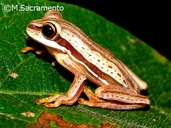|
Description
This recently described species belongs to the H. polytaenius clade, within the H. pulchellus group (Faivovich et al. 2005), in the H. polytaenia species group according to the original description (Caramaschi and Cruz 2004). It is relatively small for the group (males 24-29 mm, females 33-34 mm SVL). The head is narrow and the body is elongated. Like other members of the H. polytaenius clade, it possesses a dorsal pattern composed of brown stripes. The snout is rounded in dorsal view. Eyes lateral and prominent. Single, developed vocal sac. Tympanum is rounded and a small, supratympanic fold is visible, reaching the arm. Dorsal surface smooth; belly and ventral surface of the thigh with granulations. A single large prepollex is present, with a curved spine. Finger discs small. Metatarsal tubercles small. This frog bears a supracloacal crest but the calcaneous appendix is absent. Distribution and Habitat
Country distribution from AmphibiaWeb's database: Brazil
Found in SE Brazil, in southern Minas Gerais state. Until 2006 this species was known only from the type locality in Poços de Caldas, 1,200 m a.s.l. Its distribution has since been extended about 120 Km ESE, to the municipality of Pedralva (Orrico and Luna-Dias Neto 2006). H. beckeri is also known from Lambari, Carrancas and São Tomé das Letras (Acioli and Toledo 2008) another locality in Minas Gerais state. The species is more commonly found on rainy days, in open areas, near small permanent rivulets or temporary ponds with marginal vegetation composed of Poaceae and Cyperaceae, and small bushes, and less commonly at the forest edge (pers. obs.). Life History, Abundance, Activity, and Special Behaviors
Males of this species call at night from low vegetation. It is found at low density, after heavy rains, and only in the rainy season. Few specimens were collected between September and March (Caramaschi and Cruz 2004; Orrico and Luna-Dias Neto 2006, pers. obs.). It is likely that the reproductive mode is similar to other members of the H. polytaenius clade with eggs and exotrophic tadpoles in lentic water, that is, reproductive mode 1 of Haddad and Prado (2005). More detailed data on life history, abundance, and calling activity are needed to correctly assess the conservation status of this species. Tadpoles are unknown, though their ecology could be similar to other members of the H. polytaenius clade (see also the recent review of tadpoles of the genus Hypsiboas in Kolenc et al. (2008) with the general characterization of the tadpoles of the H. pulchellus species group). The advertisement call was recently described by Acioli and Toledo (2008): the call is given sporadically, and composed of 2 notes; the first note is longer and has more pulses than the second note, which may be emitted or not.
Trends and Threats
Its range is within at least one protected area (the Parque Estadual Nova Baden, at Lambari-MG). Population fluctuations seem to be common. Possible reasons for amphibian decline General habitat alteration and loss
Habitat modification from deforestation, or logging related activities
Intensified agriculture or grazing
Drainage of habitat
Long-distance pesticides, toxins, and pollutants
Comments
The epithet of this species was given in honor of the Prof. Johann Becker.
References
Acioli, E. C. S., and Toledo, L. F. (2008). ''Amphibia, Anura, Hylidae, Hypsiboas beckeri: Filling gap and description of its advertisement call.'' Check List, 4, 182–184.
Caramaschi, U. and Cruz, C.A.G. (2004). ''Duas novas espécies de Hyla do grupo de H. polytaenia Cope, 1870 do Sudeste do Brasil (Amphibia, Anura, Hylidae).'' Arquivos do Museu Nacional, 62, 247-254.
Faivovich, J., Haddad, C. F. B., Garcia, P. C. A., Frost, D. R., Campbell, J. A., Wheeler, W. C. (2005). ''Systematic review of the frog family Hylidae, with special reference to Hylinae: phylogenetic analysis and taxonomic revision.'' Bulletin of the American Museum of Natural History, (294), 1-240. [link]
Haddad, C. F. B., and Prado, C. P. A. (2005). ''Reproductive modes in frogs and their unexpected diversity in the Atlantic Forest of Brazil.'' BioScience, 55, 207-217.
Kolenc, F., Borteiro, C., Alcalde, L., Baldo, D., Cardozo, D., and Faivovich, J. (2008). ''Comparative larval morphology of eight species of Hypsiboas Wagler (Amphibia, Anura, Hylidae) from Argentina and Uruguay, with a review of the larvae of this genus.'' Zootaxa, 1927, 1-66.
Orrico, V.G.D. and Luna-Dias Neto, C. (2006). ''Hypsiboas beckeri – Distribution extension.'' Herpetological Review, 37, 358.
Originally submitted by: Diogo B. Provete (first posted 2008-11-27)
Edited by: Kellie Whittaker (2009-01-25)Species Account Citation: AmphibiaWeb 2009 Boana beckeri: Perereca-de-pijama <https://amphibiaweb.org/species/6452> University of California, Berkeley, CA, USA. Accessed Jan 2, 2025.
Feedback or comments about this page.
Citation: AmphibiaWeb. 2025. <https://amphibiaweb.org> University of California, Berkeley, CA, USA. Accessed 2 Jan 2025.
AmphibiaWeb's policy on data use.
|



 Map of Life
Map of Life